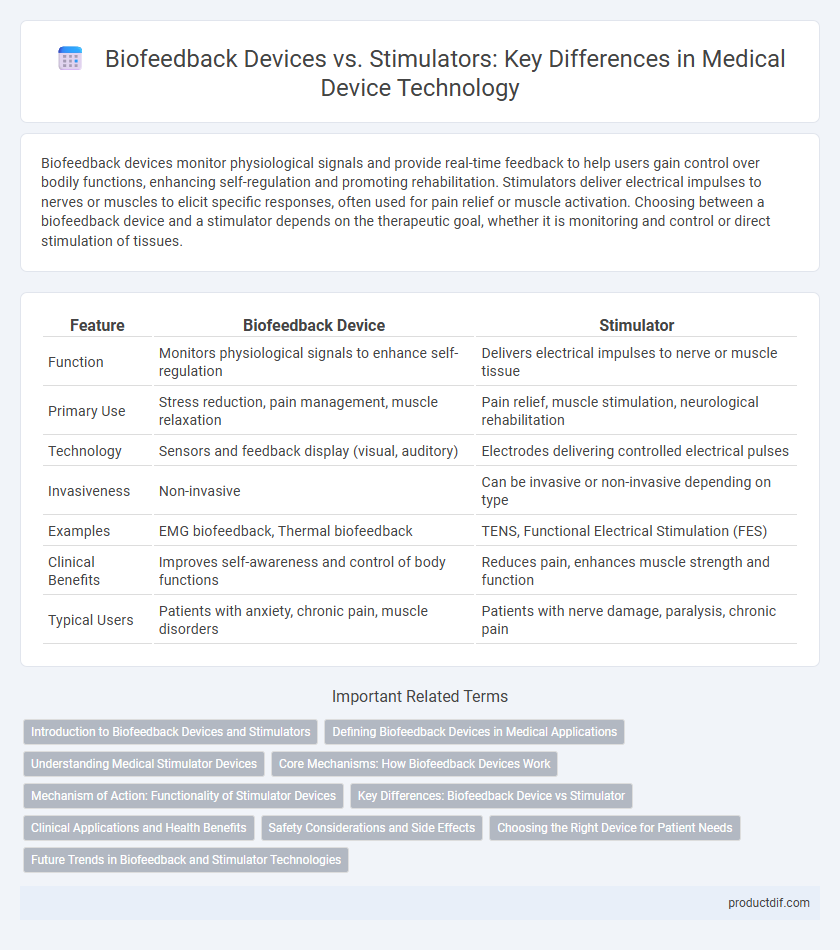Biofeedback devices monitor physiological signals and provide real-time feedback to help users gain control over bodily functions, enhancing self-regulation and promoting rehabilitation. Stimulators deliver electrical impulses to nerves or muscles to elicit specific responses, often used for pain relief or muscle activation. Choosing between a biofeedback device and a stimulator depends on the therapeutic goal, whether it is monitoring and control or direct stimulation of tissues.
Table of Comparison
| Feature | Biofeedback Device | Stimulator |
|---|---|---|
| Function | Monitors physiological signals to enhance self-regulation | Delivers electrical impulses to nerve or muscle tissue |
| Primary Use | Stress reduction, pain management, muscle relaxation | Pain relief, muscle stimulation, neurological rehabilitation |
| Technology | Sensors and feedback display (visual, auditory) | Electrodes delivering controlled electrical pulses |
| Invasiveness | Non-invasive | Can be invasive or non-invasive depending on type |
| Examples | EMG biofeedback, Thermal biofeedback | TENS, Functional Electrical Stimulation (FES) |
| Clinical Benefits | Improves self-awareness and control of body functions | Reduces pain, enhances muscle strength and function |
| Typical Users | Patients with anxiety, chronic pain, muscle disorders | Patients with nerve damage, paralysis, chronic pain |
Introduction to Biofeedback Devices and Stimulators
Biofeedback devices monitor physiological functions such as heart rate, muscle tension, and skin temperature, providing real-time data to help users gain control over bodily processes for improved health outcomes. Stimulators, on the other hand, deliver electrical or mechanical impulses to nerves or muscles to induce specific physiological responses, often used in pain management or muscle rehabilitation. Both devices play critical roles in medical therapy by either enhancing patient self-regulation or actively modulating bodily functions to promote healing and recovery.
Defining Biofeedback Devices in Medical Applications
Biofeedback devices in medical applications monitor physiological functions such as heart rate, muscle tension, or brainwave activity, providing real-time data that enables patients to gain voluntary control over these processes. Unlike stimulators that deliver electrical impulses to provoke muscular or nerve responses, biofeedback systems rely on sensory feedback to encourage self-regulation and promote healing. These devices are commonly used in managing stress, chronic pain, and rehabilitation by enhancing patient awareness and activating natural bio-regulatory mechanisms.
Understanding Medical Stimulator Devices
Medical stimulator devices deliver targeted electrical impulses to nerves or muscles to alleviate pain, restore function, or promote tissue healing. Unlike biofeedback devices that monitor physiological signals for patient-driven control, stimulators actively modulate biological responses to achieve therapeutic outcomes. Key applications include neuromodulation, functional electrical stimulation, and pain management therapies.
Core Mechanisms: How Biofeedback Devices Work
Biofeedback devices operate by monitoring physiological signals such as heart rate, muscle tension, or skin temperature and providing real-time feedback to help users gain voluntary control over these functions. These devices use sensors to detect bodily responses and software algorithms to translate this data into visual or auditory cues that guide behavior modification. Unlike stimulators, which directly apply electrical impulses to nerves or muscles to elicit a response, biofeedback devices rely on the user's active participation to achieve therapeutic outcomes.
Mechanism of Action: Functionality of Stimulator Devices
Stimulator devices operate by delivering electrical impulses to targeted nerves or muscles, enhancing motor function and pain relief through neuromodulation. Unlike biofeedback devices that monitor physiological signals to promote self-regulation, stimulators actively induce physiological responses by directly modulating neural or muscular activity. Common examples include TENS units and implantable neurostimulators used in chronic pain and movement disorder treatments.
Key Differences: Biofeedback Device vs Stimulator
Biofeedback devices monitor physiological signals such as heart rate, muscle tension, or skin temperature, providing real-time feedback to help users gain control over involuntary bodily functions. Stimulators, by contrast, actively deliver electrical impulses or other forms of energy to targeted tissues to induce muscle contractions or modulate nerve activity for therapeutic effects. The key difference lies in biofeedback's role in self-regulation through sensory input, whereas stimulators directly alter physiological functions through external intervention.
Clinical Applications and Health Benefits
Biofeedback devices monitor physiological signals such as heart rate, muscle activity, and skin temperature to help patients gain awareness and control over bodily functions, proving effective in managing stress, anxiety, and chronic pain. Stimulators, including transcutaneous electrical nerve stimulators (TENS) and spinal cord stimulators, deliver electrical impulses to nerves or muscles to relieve pain, enhance muscle function, and improve neurological conditions like neuropathy or stroke rehabilitation. Both devices offer non-invasive treatment options with clinical applications spanning pain management, neuromuscular re-education, and enhanced patient self-regulation for improved overall health outcomes.
Safety Considerations and Side Effects
Biofeedback devices provide real-time physiological data to patients, reducing risks by promoting non-invasive self-regulation without direct electrical stimulation. Stimulators, such as TENS units, carry potential side effects including skin irritation, muscle twitching, or, in rare cases, interference with implanted devices, necessitating careful patient screening and device-specific safety protocols. Understanding these differences is critical for selecting appropriate therapies while minimizing adverse reactions in clinical and home settings.
Choosing the Right Device for Patient Needs
A biofeedback device provides real-time physiological data, enabling patients to consciously regulate body functions, ideal for stress management and rehabilitation. Stimulators deliver targeted electrical impulses to nerves or muscles, effectively treating pain, muscle weakness, or neurological disorders. Selecting the right device depends on specific patient conditions, therapeutic goals, and the desired balance between active participation and passive treatment.
Future Trends in Biofeedback and Stimulator Technologies
Emerging trends in biofeedback devices emphasize real-time physiological data monitoring combined with AI-driven personalized therapy, enhancing treatment efficacy for neurological and chronic conditions. Stimulator technologies are advancing with miniaturized, implantable neurostimulators offering targeted electrical modulation for disorders like Parkinson's disease and chronic pain. Integration of wireless connectivity and IoT capabilities in both devices supports continuous health tracking and remote clinical interventions, signaling a shift toward more adaptive, patient-centric medical solutions.
Biofeedback device vs Stimulator Infographic

 productdif.com
productdif.com